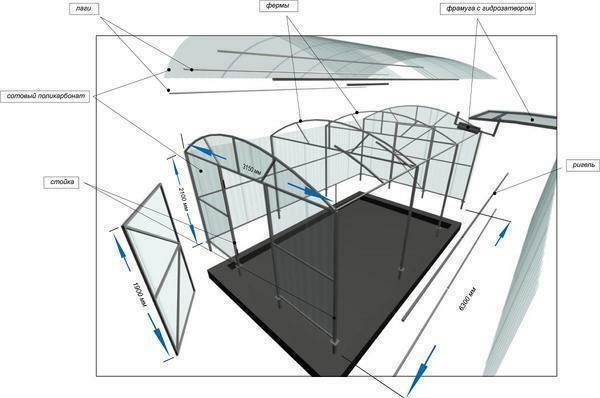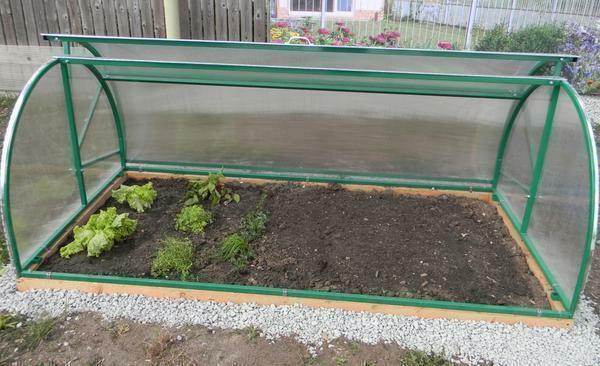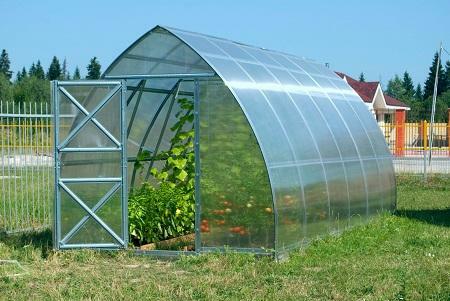 Polycarbonate is a suitable material for finishing any size of greenhouse. Polycarbonate greenhouse is an attractive structure that allows to make the most favorable conditions for growing different crops. The greenhouse received its properties thanks to a modern, heavy-duty, lightweight material - polycarbonate. What models of polycarbonate offers a modern market of roofing materials and what to consider when selecting sheets - read below.
Polycarbonate is a suitable material for finishing any size of greenhouse. Polycarbonate greenhouse is an attractive structure that allows to make the most favorable conditions for growing different crops. The greenhouse received its properties thanks to a modern, heavy-duty, lightweight material - polycarbonate. What models of polycarbonate offers a modern market of roofing materials and what to consider when selecting sheets - read below.
-
- Properties of polycarbonate for greenhouses
- Polycarbonate thickness for greenhouses
- Size of polycarbonate sheet for greenhouses: length and width
- Which color of polycarbonate is better for a greenhouse
- Recommendations: which polycarbonate to choose for a greenhouse
- Polycarbonate for greenhouses: which is better( video)
Properties of polycarbonate for greenhouses
Polycarbonate is a flexible plastic that has a light weight and high light transmissionth power. Most often, honeycomb polycarbonate is chosen to cover greenhouses: its air layer imparts high thermal insulation properties to the material.
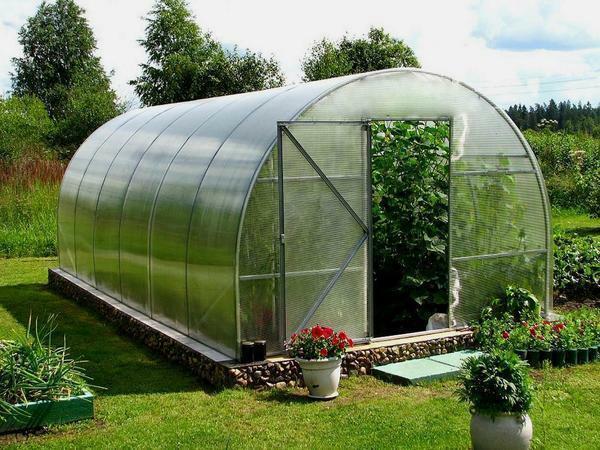 The advantages of polycarbonate include the long life and durability of
The advantages of polycarbonate include the long life and durability of
In addition, the polycarbonate advantageously differs:
- High strength. Impact resistance of polycarbonate exceeds the same figure for glass in a hundred, and sometimes two hundred times.
- High level of thermal insulation. The index of thermal insulation in polycarbonate is two times higher than that of glass. This allows to save considerably the costs of heating winter greenhouses( up to 30%).
- Easy installation. Install the sheets on the frame with their own hands can any, even if not having a building experience, gardener.
- Light weight. In comparison with glass, polycarbonate is much easier. This allows you to save money on the organization of the frame( for glass you need only a high-strength frame, capable of withstanding the weight of material and sediments).
- Flexibility. The material can be easily bent even without heat treatment( which allows it to be mounted on arched frames).
- Resistant to the effects of temperature, UV rays of moisture. Polycarbonate sheets do not lose their properties at temperatures ranging from -40 to +120, well withstand gusts.
At the same time, it is very easy to care for such a coating: polycarbonate is easy to clean with warm soapy water.
Thickness of polycarbonate for the greenhouse
The main dimension that determines the strength of polycarbonate and which should be considered when choosing a coating for the greenhouse is the thickness of the polycarbonate sheet. For today, cellular polycarbonate is produced with a thickness in the range from 0.4 to 3.2 cm with a difference between 2 mm steps. Monolithic carbonate can be found in the thickness of 0.1-1.2 cm with the difference between the models of the series of 1 mm.
 Choose the thickness of the polycarbonate, depending on how you will operate the greenhouse
Choose the thickness of the polycarbonate, depending on how you will operate the greenhouse
The thickness of the sheets to be selected for the greenhouse coating affects:
- Type of construction. The optimum thickness of sheets for greenhouses is 6-10 mm, for the summer gardens and greenhouses use thicker material( up to 25 mm).
- The size of the greenhouse. For example, a thick polycarbonate( for example, 10 mm) has a large radius of curvature( about one and a half meters).Therefore, to cover them with low greenhouses will not work.
- Purpose of the greenhouse. The recommended thickness of sheets for the use of greenhouses only in the summer 4-6 mm, for the year-round vegetarian need more thick material( 8-16 mm, depending on the region and the amount of annual precipitation).
- Features of the locality. The thinner the carbon sheets, the easier and faster they will freeze. This plays a decisive role in the costs of heating the greenhouse in northern and windy regions.
In addition, it should be remembered that a thinner material is cheaper. So, the most affordable polycarbonate will be the "four"( thickness 4 mm).Acquiring sheets that are even thinner will not make sense, since the coating will quickly become unusable due to the influence of precipitation, UV rays, mechanical influences.
Size of polycarbonate sheet for greenhouses: length and width
Today, polycarbonate honeycomb is 210 cm wide and 600 and 1200 cm long. Monolithic polycarbonate has a standard width of 250 cm and a length of 205 cm.
When choosing polycarbonate sheetsThe length and width of the main thing is that after the greenhouse is left as little as possible of scrap material: this will reduce construction costs.
Therefore, greenhouses are usually constructed in such a way that the load-bearing elements are located from each other at a distance of 210-250 cm: this distance lies on the width of the sheet.
Determine the size of the two proposed can be selected by measuring the front side of the greenhouse: the sheet must cover it completely.
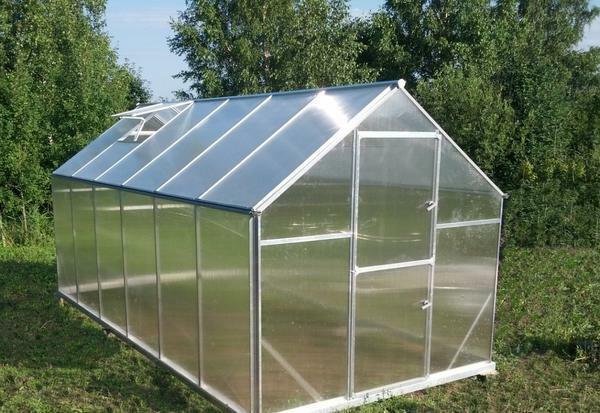 Before buying polycarbonate, you need to perform the necessary measurements of the frame of the greenhouse and record them on paper
Before buying polycarbonate, you need to perform the necessary measurements of the frame of the greenhouse and record them on paper
In addition, it is important and the method of mounting the sheets: if the polycarbonate is to be lapped, then the sheets should be taken wider in size. All sheets must be of the same size.
In order to select the polycarbonate along the length, the length of the supporting structures( arcs of the greenhouse) should be measured: the sheet must be sufficient to completely wrap the arc.
The lower the greenhouse, the smaller the length of the sheets. Greenhouses with a height of 2 meters, usually covered, placing the sheets horizontally: so that the width fell to the height of the greenhouse. In this case, the direction of the cells should be taken into account: the water from them must flow freely.
When greenhouses are built with skates, the height of the sides of the greenhouse and the height of the skates are measured: these indicators often coincide, which allows to select the sheets so that after the coating they leave no residue.
What color polycarbonate is better for a greenhouse
Today, polycarbonate manufacturers offer transparent, matt and colored( colored) sheets. Each model with different coating has different light transmission capacity. The choice of coverage depends on what crops will grow in the greenhouse garden. For example, mat polycarbonate is used to grow crops that need a shadow( for example, fungi) or plant cultivation in hot, southern regions.
Transparent polycarbonate panels have the highest light transmission capacity( up to 96%), color polycarbonate transmits up to 65% of light, and matte - from 20 to 70% of light rays.
 It is best to choose a transparent polycarbonate as it passes the sun's rays into the inside of the greenhouse
It is best to choose a transparent polycarbonate as it passes the sun's rays into the inside of the greenhouse
Colored sheets have selective throughput: some rays of the spectrum they miss, others they delay. Experienced gardeners have learned to use this feature. So, for example, in violet shades it is good to grow plants in regions with a short light day: under the influence of rays of this color, plants start to bloom more quickly and bear fruit.
For the cultivation of fruit crops in hothouses, shades of red and orange are best suited.
Blue color has a favorable effect on the development of green mass of plants, and red - on ripening of fruits. It is strictly forbidden to use green polycarbonate for covering greenhouses: it is under the green rays of the plant that it begins to slow down its growth, becomes weak and stops development.
Recommendations: which polycarbonate to choose for a greenhouse
After the choice of polycarbonate in size and color has been carried out, you should pay close attention to the purchase of material. Only high-quality polycarbonate can provide plants with the necessary amount of light, protect the premises of the greenhouse from wind, cold, precipitation.
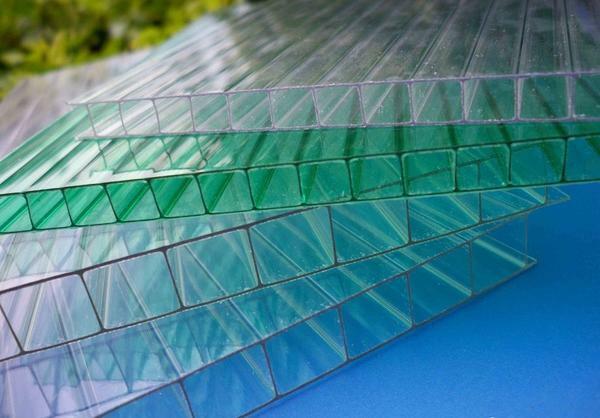 When polycarbonate is selected for it, you should press: it should not have any dents.
When polycarbonate is selected for it, you should press: it should not have any dents.
To select a quality polycarbonate, you must follow these recommendations:
- Do not save on material. Many sellers recommend a more affordable lightweight polycarbonate. This product, although it has a low cost, but is suitable only for use in warm countries. In our climate, it can not create the proper level of thermal insulation, and due to thin walls and partitions, such material can not withstand large deposits and guarantee the strength of the structure.
- Pay attention to well-known brands and brands. Only buying products from companies that have proven themselves well will be able to guarantee quality coverage. For today, known manufacturers of polycarbonate are such firms as: SafPlast Innovative, Bayer Makrolon, Polygal, lastiLux.
- Bring a ruler with you. Often manufacturers, for the sake of economy, produce sheets with a thickness less than the declared.
- Consider the weight of the sheet. If you are offered a sheet weighing 8-8.5 kg, then you have a lightweight analog that does not differ in strength and durability. The weight of the standard polycarbonate sheet should be at least 10 kg.
- Check the documentation. Quality products must have accompanying documentation with full information about the product( manufacturer, dimensional characteristics, UV protection level).
It is not superfluous to see on the Internet reviews about the operation of goods of a particular brand.
Polycarbonate for greenhouses: which is better( video)
Polycarbonate is the material that is ideal for covering greenhouses. It has a small weight, while it has high strength and thermal insulation properties. The quality of polycarbonate depends on its density. In addition, when selecting sheets, pay attention to the length and width, color and transparency of the sheets. Use the recommendations for choosing a polycarbonate for the greenhouse, and enjoy a durable coating and a great, quality harvest!

